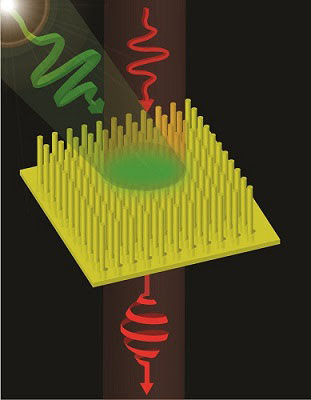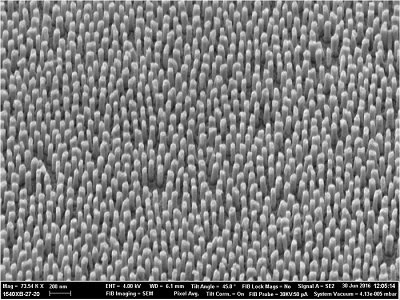
All-Optical Polarization Control Could Allow Faster Data Transfer
A breakthrough in rapid polarization switching with an all-optical polarization control could allow faster data transfer and open new areas of nanoresearch, enabling researchers to learn more about unseen nanoscale worlds such as drug chemistry and quantum electronics.

Illustration showing light polarization being changed by the metamaterial. Courtesy of King’s College London.
Scientists at King’s College London have developed the ultrafast method of changing the fundamental properties of light with light.
Current electronic methods used to control polarization are reaching physical speed limits. Now, researchers at King’s have overcome this issue, allowing polarization to be switched at timescales of less than a millionth of a millionth of a second — hundreds of times faster than current electronic methods.
“The fastest commercially available product operates at a rate of 40 GHz,” said King’s Ph.D. student Luke Nicholls. “We report a switching rate of over 300 GHz — so our metamaterial approach could switch polarization around 7.5 times faster than the best current techniques.”
Nicholls told Photonics Media that current polarization switching approaches to observe chemical processes are also not fast enough for some applications.
“Chemical processes tend to happen very fast, but if you can quickly switch to different polarization states of light and observe how they interact with the chemical as it is being made, drug developers can understand the processes that lead to unwanted configurations and remedy them,” said Nicholls.
The scientists designed metamaterials out of gold nanoparticles for their experiments. When they fired a high intensity light pulse into the metamaterial — injecting energy into the electrons in gold particles — the refractive index of the material changed.
A second pulse was fired at the metamaterial at the same time. As this pulse passed through the material, the change in refractive index changed its polarization.
By simply shining two beams of light through the material, one beam is able to control the polarization of the other at ultrafast speed, instantaneously allowing polarization to be changed trillions of times per second.
“Light is the ultimate tool of science, and a large part of our understanding of the world around us comes from observing light’s interaction with the stuff it encounters,” said Nicholls. “The greater control we have over light and its defining characteristics, such as polarization, the more we can understand and probe the materials light interacts with.”

Scanning electron microscope image of the sample surface. Courtesy of King’s College London.
The King’s team’s polarization switching material is proven now and ready for applications where infrastructure exists to benefit from it. The metamaterial design is made via a self-assembly technique, which allows large-area uniform samples of the metamaterial to be made easily and cheaply. The researchers say the fabrication process could be easily scaled up for mass production.
The paper, “Ultrafast synthesis and switching of light polarization in nonlinear anisotropic metamaterials,” has been published in the journal Nature Photonics (doi: 10.1038/s41566-017-0002-6).
Published: September 2017